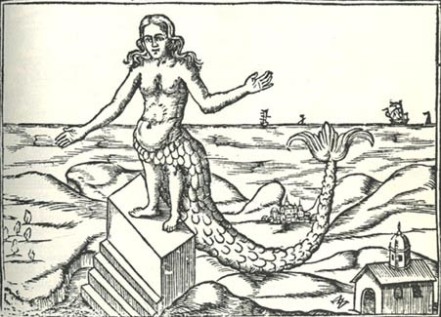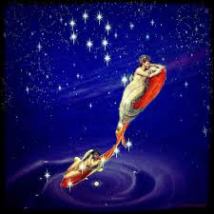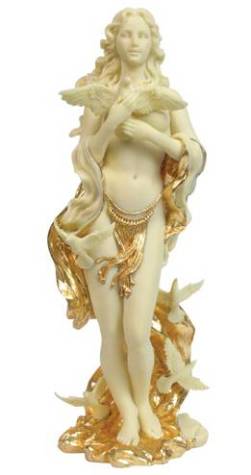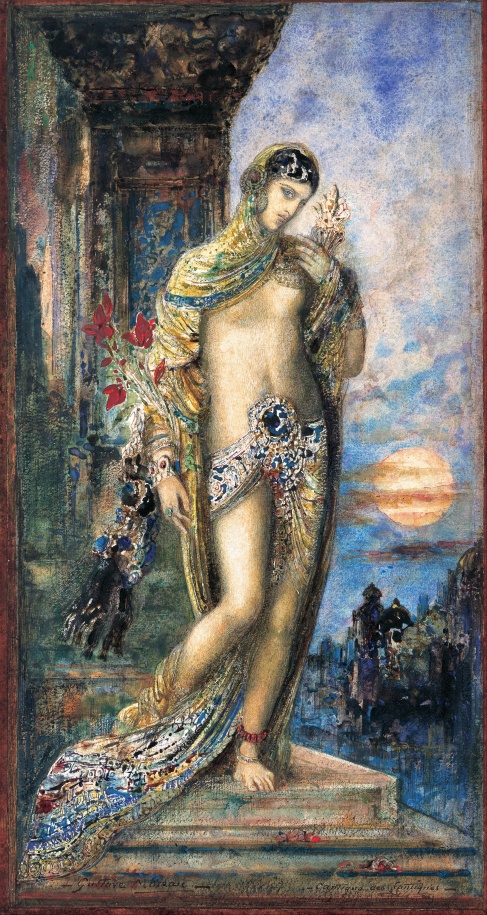Aphrodite of Corinth
Beyond light and shade,
Beyond thing and thought,
There is love forever lurking.B.Z. Goldberg, The Sacred Fire
Among the many totems of the great Babylonian goddess Ishtar was the fish. Her initiates would eat it as part of fertility rites that she presided over. According to a Babylonian story that I repeat here after Liz Greene two fishes found a giant egg in the Euphrates. They moved it to the land, where a dove settled on it. From the egg emerged a great goddess Atargatis, who requested the fish to be placed in the heavens as the sign of Pisces.
Atargatis
In a Greek myth, Aphrodite and her son Eros flee from the monster Typhon disuguised as two fishes.
Eros and Aphrodite
We can see the sign of Pisces as the great fertility goddess paired with her son, who in these ancient cultures was also her lover. In ancient matriarchal cultures, a cyclical union of the goddess and her consort ensured fertility for the land. The most important ritual was the hieros gamos (sacred marriage) between the select priestess of the goddess (chosen to be her embodiment) and the reigning monarch or the high priest. In very ancient cultures the monarch was actually ritually dismembered and sacrificed during those rites. Such a ritual assured fertility for the whole land ad its people. A lot of scholars believe that sacred prostitution was born as the development of that ritual:
In the ancient matriarchies, nature and fertility were the core of existence. … Desire and sexual response experienced as a regenerative power were recognized as a gift or a blessing from the divine.
Nancy Qualls-Corbett, The Sacred Prostitute: The Eternal Aspect of the Feminine
I mentioned fish specifically in connection with the Age of Pisces that we are currently in. Liz Greene writes about the Piscean tendency to disassociate from the world of instinct out of fear of being devoured by the Great Mother. I think that our mainstream culture may be doing precisely that. The revival of the sacred feminine correlates with the crisis within the monotheistic church. Much has been written about the repression of the feminine and the need to reinstate her importance. In the preface to Nancy Qualls-Corbett’s book, Marion Woodman (a Jungian analyst and a key figure in women’s movement) wrote about that deep wound that is so palpable in our culture:
Love had become disassociated from the body in order for human beings to reach a purely spiritual union with god. … No longer seen as the gift of the divine, woman’s sexuality was debased and exploited. The very quality for which woman once had been considered sacred now became the reason for which she was degraded.
In ancient times the goddess was worshiped and venerated. That last word is especially meaningful because its etymology is connected with the Roman goddess Venus, direct descendant of the Greek Aphrodite. One city that revered Aphrodite most was the port of Corinth. In fact, Aphrodite was a counterpart of the Phoenician fertility goddess Astarte, whose cult was adopted by the Greeks. Corinth also adopted the Phoenician rituals of sacred prostitution.
Aphrodite
I am aware of the ongoing fierce debate between scholars whether the so called sacred prostitutes were not used by temple priests to make profits. I also realize that even using the word ‘prostitute’ is risky. Liz Greene suggests using the word harlot instead, which is interesting. I would like to point out, however, that the notion of sex for hire is not inherent in the etymology of the word ‘prostitute’, regardless of our modern connotations. Etymologically, it means something like “exposed to lust, standing erect.” I love Nancy Qualls-Corbett’s book because it focuses on the image and the archetype of the sacred prostitute, on its purest expression and not on its often distorted manifestation. A sacred prostitute was first and foremost the woman who embodied the goddess:
…she is the consecrated priestess in the temple, spiritually receptive to the feminine power flowing through her from the Goddess, and at the same time joyously aware of the beauty and passion in her human body. … She opens the masculine to the potency of penetrating to the divine, and the feminine to the rapture of surrender to it.
As a human race, we share certain images (archetypes) via the collective unconscious. The archetype of the goddess of love is a very vibrant image that can imbue us with lust for life and spiritual renewal. Without her life is empty, barren and meaningless. She gives us the erotic dynamism of the instincts:
In the temple of love the sacred prostitute’s primary offering to the goddess was her welcoming of the stranger… With the stranger she was awakened to her innate feminine nature of giving, reciving and containing love. To him the sacred prostitute offered a rekindling of the divine spark of life … (Nancy Qualls-Corbett)
The union that was achieved with a stranger in a temple was viewed ecstatic and transpersonal. The priestesses did not offer their bodies in exchange for power or favours. A stranger was not someone who was able to satisfy the female ego by giving her security or a sense of identity. She did not possess the stranger nor was she possessed by him. The symbolic meaning of the stranger suggests an aspect of the unconscious that suddenly breaks into consciousness in order to instigate change. As a result of this encounter, both the stranger and the female priestess are transformed. The priestess acts as the Jungian anima, which Erich Neumann described in The Great Mother as “the mover, the instigator of change, whose fascination drives, lures, and encourages the male to all the adventures of the soul and spirit, of action and creation…” She mediates between consciousness and the nonhuman realm of the goddess (the unconscious).
In a highly recommended The Women’s Encyclopedia of Myths and Secrets, Barbara G. Walker devotes six long pages to sacred prostitution and it is a very engrossing read. Here is the very first bunch of quotes that captivated my attention:
As Mother of Harlots, Ishtar was called the great goddess HAR. Her high priestess the Harine was spiritual ruler of “the city of Ishtar.” HAR was a cognate of the Persian houri and the Greek hora…
Shulamite of the Biblical Son of Songs, allegedly a priestess to Ishtar; painting by Gustave Moreau
Houris were dancing “Ladies of the Hour” who kept time in heaven and tended the star-souls.
Egyptian temple-women also were Ladies of the Hour. Each ruled a certain hour of the night, and protected the solar boat of Ra in the underworld during his passage through her hour. The Dance of the Hours began as a pagan ceremony of the Horae (divine “Whores”) who kept the hours of the night by dances as Christian monks later kept the hours of the day by prayers.
Edward John Poynter, Horae Serenae
The priestesses danced around the omphalos (the feminine hub of the universe). They were also known as Charites or Graces, since they expressed a combination of beauty and kindness called charis (Latin caritas), which is related to Hindu karuna meaning mother love, tenderness, comfort, enlightenment and sex. A lot of these women had very high social status and were revered for their learning, wisdom and healing faculties. They were legally and politically equal to men.
For me, the great harlot remains a mystery, a woman behind a veil. She treads the holy ground of life, passion and creation. To misquote the great Greek poetess Sappho, thanks to her we do not let our hearts grow cold, we do not let our wings down.


















“The symbolic meaning of the stranger suggests an aspect of the unconscious that suddenly breaks into consciousness in order to instigate change. As a result of this encounter, both the stranger and the female priestess are transformed. ”
This is very rich, as is the entire post. I am a big fan of Marion Woodman. Lots to ponder here, thank you again for sharing with us!
Debra
LikeLike
I noticed how we get excited by the same stuff, Debra. I am fascinated by the symbolism of an encounter with a stranger. It’s also the theme of great literature.
LikeLike
Yes, it seems we do! Something very romantic about the notion of a stranger. 🙂
LikeLike
At first according to the title I thought the post was about me. 😀 Joking~ Great, great piece Monika, should be in a publication.
This bit, “…woman’s sexuality was debased and exploited” I believe was so deeply intentional on the part of the dark demiurge forces that have controlled this planet from then until now. They were very successful with that distortion and through the entire balance of the divine hermaphrodite out of whack. By their distorting of sacred sex, the masses have been cut off from the great force available to commune with the Source Creator.
The Goddess is back! Thanks Monika, you are so brilliant, beautiful and talented. Are you publishing soon?
LikeLike
Sindy, you are much too kind, but thank you so much. Of course the title is about you, about all of us!
Much love,
Monika
LikeLike
It is about all of us. We are sexually divine beautiful goddesses.
✿ღ✿ღ.¸¸ღ♫*¨`*•..¸ƸӜƷ ✿ღ ✫❀
I am not too kind, its just a fact. 🙂
Namaste
Sindy
LikeLike
You didn’t comment on the meat of what I said, did I sound crazy?
LikeLike
No, no, not crazy. I was very flattered, thanks again.
LikeLike
I liked the stranger aspect/symbolism also…
to me it is the primal energy of freedom in souls….not tethered or bound..
not sure that makes sense….
good post…much to read again and think more again…
Take Care…
)0(
LikeLike
Thank you, Maryrose. The freedom of untethered souls is also something that appeals to me.
LikeLike
I think you really presented this concept beautifully.
LikeLike
Thank you – I tried to be tactful.
LikeLike
well, you did it quite gracefully. 🙂
LikeLike
I enjoyed this article, because I’ve always believed that we live in a ‘man’s world’ because as a collective, we have denied the sacred feminine, the spirit. Today women’s ’emancipation’ isn’t real; its just a further retreat as women emulate men. True equality will arise when women are women without apology and men embrace their femininity. I’ve noticed that truly balanced men always have a well-developed feminine side. I’m off to look for Barbara G. Walker!
LikeLike
I agree with you about the need of women to embrace their feminity without any patriarchal value judgements. About the book, I have got to warn you that the second part is quite dry and scholarly – lots of dream analysis. I much prefer Marion Woodman with her sensual, evocative style.
LikeLike
Thank you for this lovely post. I was first exposed to the concept of sacred prostitution through reading “When God Was a Woman” by Merlin Stone. I am sure that you are aware of the existence of controversies regarding sacred prostitution in antiquity, with some researchers going so far as to say it’s an outright myth. I myself have not decided on whether it did or did not exist, but it is food for thought. I believe that if it did exist, the concept behind it, and sexuality in general, was far different from modern prostitution and sexuality.
LikeLike
I am happy you enjoyed the post. I am aware that some scholars question it. I have read that what Herodotus wrote about the Babylonian brides-to-be who would lose their virginity in temples was not true. All I wanted was to talk about sacred prostitution as an archetypal concept. I think it’s extremely evocative as such.
LikeLike
This is so interesting – and that painting by Moreau is absolutely stunning. I’ve never seen anything like it. This post has left me pondering a good many questions, especially the ways in which female sexuality has been degraded – and, similarly, its fruits – motherhood. I was just reading a post by a woman who wrote in great detail about the ways in which motherhood had created a second class citizen status in her country (my country, too, the U.S.) What I find most striking is the idea that these women were highly educated and on equal footing with men socially. These days sexuality and intellectualism are perceived as mutually exclusive, likewise motherhood and intellectualism. You’ve got me thinking already this morning! Wonderful post : )
LikeLike
Thank you for this extremely thoughtful comment. So true about motherhood and sexuality and their degradation in our culture.
LikeLike
“she is the consecrated priestess in the temple, spiritually receptive to the feminine power flowing through her from the Goddess, and at the same time joyously aware of the beauty and passion in her human body. … She opens the masculine to the potency of penetrating to the divine, and the feminine to the rapture of surrender to it.”
Speaks to my heart. Thanks for the post and the many useful references!
LikeLike
Thank you for reading and commenting. I am also in love with that particular quote.
LikeLike
Reblogged this on Lactobacillus Bulgaricus and commented:
I am very thankful for this post by Symbol Reader. I got lost into one of her references: “The Sacred Prostitute: Eternal Aspect of the Feminine” by Nancy Qualls-Corbett. It echoed many of my own intuitions on the subject and allowed me to sense just how much programming there has been for our societies to forget and completely debase a very substantial aspect of feminine nature, closely related to life and fertility. A valid question: Is it for this reason that our culture feels so barren -in its social structures, human relationships, in its religion and in its science? Another valid question: How can we bring this archetype back as a part of out existence, under current conditions and levels of development of the mind? A very important issue here is the integration of sexuality and spirituality – two concepts that have been unnaturally separated in history to bring the current state of affairs in our world. A very enlightening read – meaning both the post and the book.
LikeLike
Thank you for such beautiful words. I think you are asking very significant questions. This archetype is very much alive in the psyche of modern women. I am grateful for the reblog.
LikeLike